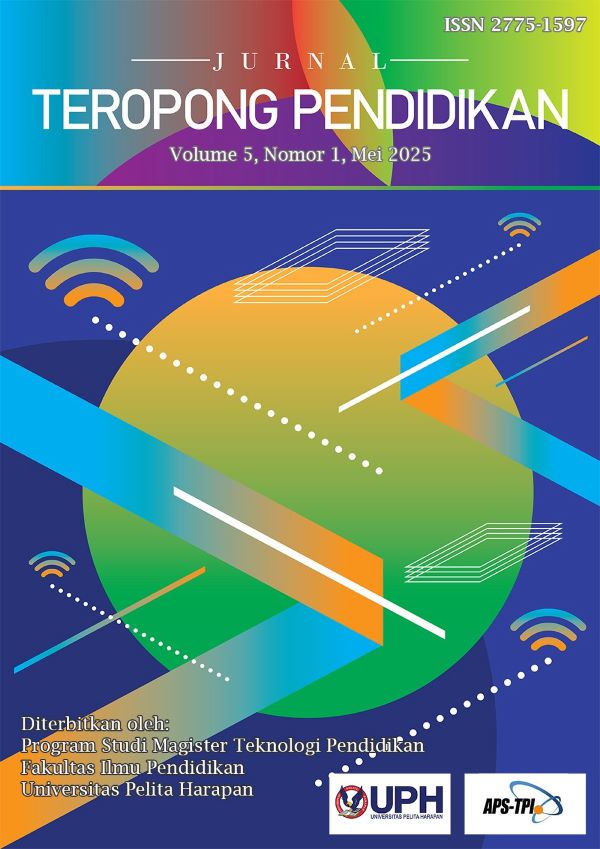Efektivitas QR Code sebagai Media Akses Konten Digital pada Buku Mata Pelajaran Biologi untuk Meningkatkan Pemahaman Siswa SMA Kelas XI [The Effectiveness of QR Code as a Media for Accessing Digital Content in Biology Textbooks to Improve the Understanding of Grade XI High School Students]
DOI:
https://doi.org/10.19166/jtp.v5i1.9467Keywords:
QR Code, Digital Access Media, Student Comprehension, Quasi-ExperimentAbstract
This research aims to explore the effect of QR codes as a digital content access tool in high school biology textbooks on the comprehension of 11th-grade students and to examine potential gender-based differences. Adopting a quasi-experimental design with a post-test-only non-equivalent group model, the study compared an experimental group (students using QR codes) and a control group (students not using QR codes). Data was collected through a standardized post-test given to thirty students in each group, following validity and reliability tests conducted on a different set of thirty students. The data analysis included normality tests, homogeneity tests, and hypothesis testing to analyze the quantitative data. The results revealed a significant improvement in the comprehension of students using QR codes, as their post-test scores were considerably higher than those in the control group. Statistical analysis of averages confirmed the effectiveness of QR codes in offering additional accessible and engaging content, such as videos, images, and articles related to the subject. Interestingly, no significant difference in comprehension was found between male and female students, suggesting that the advantages of QR codes are evenly distributed across genders. This study highlights the value of QR codes as a digital content access medium for enhancing learning outcomes in secondary school biology education, fostering an interactive and comprehensive learning experience.
References
Aliyah, H., & Masyithoh, S. (2024) Tinjauan literatur: Peran teknologi digital dalam meningkatkan kualitas pembelajaran di sekolah. Jurnal Teknologi Pendidikan dan Pembelajaran, 1(4), 681–687. https://jurnal.kopusindo.com/index.php/jtpp/article/view/153
Ariyandi, H. Z., & Handayani, A. N. (2022). Peran penggunaan teknologi QR code untuk meningkatkan keterhubungan dan efisiensi masyarakat menuju era transformasi society 5.0. Jurnal Inovasi Teknologi dan Edukasi Teknik, 2(7), 299–306. https://doi.org/10.17977/um068v2i72022p299-306
Azizah, N. A., & Widyartono, D. (2024). Gaya belajar visual, auditorial, dan kinestetik: Temuan dari siswa kelas VII. Journal of Language Literature and Arts, 4(11), 1117–1123. https://doi.org/10.17977/um064v4i112024p1117-1123
Cendikia, M. R., Sumarmi., Taryana, D., Mutia, T., & Astina, I. K. (2024). Sintesis kebutuhan pengembangan media video pembelajaran materi geosfer berbantuan ArcGIS StoryMaps untuk meningkatkan hasil belajar siswa MA. Journal of Education Action Research, 8(3), 408–417. https://doi.org/10.23887/jear.v8i3.78615
Hamid, K., Masruhim, M. A., & Hudiyono, Y. (2020). Pengembangan media pembelajaran berbasis macromedia flash pada materi sel siswa kelas XI SMA. Edukasi, 18(1), 193–203. http://dx.doi.org/10.33387/j.edu.v18i1.1588
Muliati., Sumampouw, H. M., & Rompas, C. F. E. (2025). Analisis faktor penyebab kesulitan belajar siswa pada pembelajaran Biologi kelas XI SMA Negeri 2 Tondano Tahun Ajaran 2024/2025. Jurnal Cakrawala Pendidikan dan Biologi, 2(1), 117–132. https://doi.org/10.61132/jucapenbi.v2i1.219
Novitasari, A. T. (2023). Motivasi belajar sebagai faktor intrinsik peserta didik dalam pencapaian hasil belajar. Journal on Education, 5(2), 5110–5118. http://dx.doi.org/10.31004/joe.v5i2.1248
Prabawa, D. G. A. P., & Restami, M. P. (2022). Efektivitas konten digital menggunakan prinsip segmentasi di sekolah dasar. Mimbar Ilmu, 27(1), 72–80. https://doi.org/10.23887/mi.v27i1.41218
Sastafiana, F., Saputri, M. E., & Mufidah, L. L. N. (2024). Klasifikasi dan penggunaan media pembelajaran: Analisis dan implementasi dalam proses pembelajaran. The Elementary Journal, 2(2), 20–29. https://doi.org/10.56404/tej.v2i1.84
Sugiyono. (2021). Metode penelitian kuantitatif, kualitatif, dan R&D. Indonesia, Bandung: Alfabeta.
Suparlan, S. (2020). Peran media dalam pembeajaran di SD/MI. ISLAMIKA: Jurnal Keislaman dan Ilmu Pendidikan, 2(2), 298–311. https://doi.org/10.36088/islamika.v2i2.796
Tehusula, R. A. P., Hadjaratie, L., & Olii, S. (2023). Sistem qr-code berbasis web pada proses pengolahan data perpustakaan di Pascasarjana Universitas Negeri Gorontalo. DIFFUSION: Journal of SystemandInformation Tecnology, 3(1), 120–129. https://doi.org/10.37031/diffusion.v3i1.18269
Varenia, I. A. N., & Phalguna, I. B. Y. (2022). Implikasi media baru sebagai media komunikasi dan teknologi informasi. SADHARANANIKARANA: Jurnal Ilmiah Komunikasi Hindu Institut Agama Hindu Negeri Gde Pudja Mataram, 4(1), 623–632. http://dx.doi.org/10.53977/sadharananikarana.v4i1.614
Wisman, Y. (2020). Cognitive learning theory and implementation in learning process. Jurnal Ilmiah Kanderang Tingang, 11(1), 209–215. https://doi.org/10.37304/jikt.v11i1.88
Downloads
Published
Issue
Section
License
Copyright (c) 2025 Rudy Pratama, Sendy Wulandhary, Padre Pio

This work is licensed under a Creative Commons Attribution-ShareAlike 4.0 International License.
Authors who publish with this journal agree to the following terms:
1) Authors retain copyright and grant the journal right of first publication with the work simultaneously licensed under a Creative Commons Attribution License (CC-BY-SA 4.0) that allows others to share the work with an acknowledgement of the work's authorship and initial publication in this journal.
2) Authors are able to enter into separate, additional contractual arrangements for the non-exclusive distribution of the journal's published version of the work (e.g., post it to an institutional repository or publish it in a book), with an acknowledgement of its initial publication in this journal.
3) Authors are permitted and encouraged to post their work online (e.g., in institutional repositories or on their website). The final published PDF should be used and bibliographic details that credit the publication in this journal should be included.





